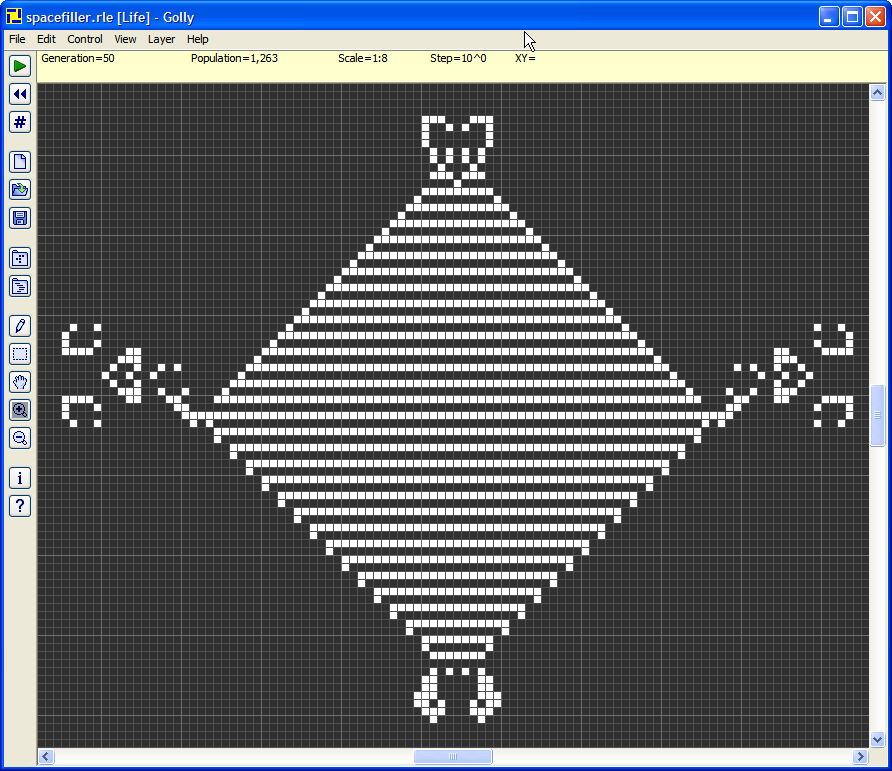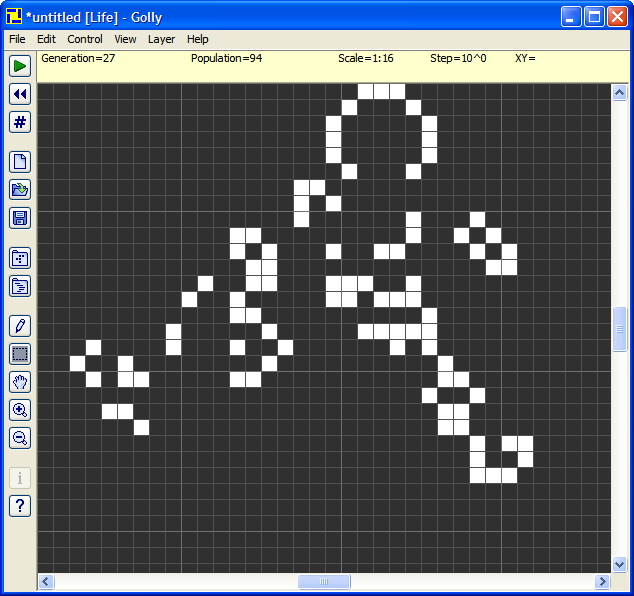Retro Replay Review
Gameplay
Golly centers around the timeless rules of Conway’s Game of Life, offering an immersive sandbox for exploring cellular automata. As soon as you launch the application, you’re greeted by a vast, scrollable grid where each cell adopts the classic life-and-death mechanics: a dead cell springs to life with exactly three neighbors, while a live cell survives on two or three neighbors. This simple rule set quickly evolves into complex, unpredictable patterns that can captivate players for hours.
(HEY YOU!! We hope you enjoy! We try not to run ads. So basically, this is a very expensive hobby running this site. Please consider joining us for updates, forums, and more. Network w/ us to make some cash or friends while retro gaming, and you can win some free retro games for posting. Okay, carry on 👍)
What truly sets Golly apart is its interactivity. You’re not limited to passive observation—while the simulation runs, you can pause at any moment to add, remove, or modify cells, essentially “helping” or “hindering” your evolving patterns in real time. An undo/redo history ensures that experimentation has no costly penalties, encouraging bold tweaks and curiosity-driven tinkering. Whether you’re coaxing a glider gun into production or dismantling a pulsar by hand, Golly’s controls feel fluid and responsive.
Beyond Conway’s original rule set, Golly ships with sixteen alternative neighborhood rules, from highlife to seeds, as well as the option to define your own custom rules. This flexibility unlocks entirely new universes of cellular behavior, making Golly less a single game and more a comprehensive platform for cellular-automaton research. If you’ve ever wondered how different birth/survival thresholds shape emergent patterns, Golly provides the perfect playground.
Graphics
Visually, Golly embraces minimalism without sacrificing clarity. The grid of square cells is rendered crisply at any zoom level, from an Earth-spanning view down to a single-cell close-up. Colors are customizable, so you can assign distinct hues to different rule sets, generations, or pattern families, keeping complex simulations comprehensible at a glance.
Performance-wise, Golly is remarkably efficient. Thanks to its Hashlife algorithm and optimized C/C++ core, even massive, infinite boards update at high speed on modest hardware. You can run thousands of generations per second, or slow things down for meticulous inspection—whichever suits your project. The result is a seamless experience free of stutter, lag, or loading screens.
If you’re a developer or modder, you’ll appreciate Golly’s scripting support. Python and Lua interfaces allow you to create custom tools, automate pattern searches, or batch-process rule variations. The built-in pattern library displays beautifully in the UI, and custom graphics (such as highlighting active cell clusters) can be overlaid via script. For a “simple” life simulator, Golly offers an unexpectedly deep graphical toolkit.
Story
At first glance, a story-driven narrative might seem out of place in a pure simulation. Yet Conway’s Game of Life carries its own meta-narrative: the saga of emergence from simple rules, the rise and fall of cell civilizations, and the ongoing quest to classify every known pattern. Golly becomes the stage where this grand mathematical drama unfolds.
Players often create “scenes” or “episodes” by curating specific initial configurations—glider collisions can feel like epic battles, oscillators like ticking metronomes in a cosmic clockwork. Golly’s pattern library includes famous constructs such as Gosper’s glider gun and the Diehard spaceship, each with its own pedigree in the Game of Life community. Loading one of these patterns is akin to opening a page of cellular automaton history.
Moreover, Golly fosters a narrative of discovery. Every new rule set, every user-contributed pattern, and every scripted experiment weaves into the larger tapestry of cellular automata research. You become both a spectator and a co-author of the Life story, watching as your own experiments earn a place in the annals of digital life.
Overall Experience
Golly strikes a remarkable balance between accessibility and depth. Newcomers can launch the app, place a few cells, and watch mesmerizing patterns evolve within seconds, while veteran researchers can dive into scripting APIs, massive infinite grids, and custom rule development. The interface remains approachable, with clear menus, pattern libraries, and tooltips guiding exploration.
Stability is another standout feature. Golly runs flawlessly across Windows, macOS, and Linux, and even on lower-end hardware. Autosave, undo/redo, and a robust crash-recovery mechanism ensure that your creations—and your time—are never lost. For a free, open-source title, the polish rivals many commercial offerings.
In the end, Golly transcends the label of a “game” to become an essential tool for educators, hobbyists, and scientists fascinated by cellular automata. Whether you’re igniting a passion for computational thinking in students or probing the frontiers of emergent phenomena, Golly provides an inviting, endlessly expandable playground. Its combination of raw computational power, intuitive controls, and boundless creative potential makes it a must-have for anyone intrigued by digital life.
 Retro Replay Retro Replay gaming reviews, news, emulation, geek stuff and more!
Retro Replay Retro Replay gaming reviews, news, emulation, geek stuff and more!








Reviews
There are no reviews yet.